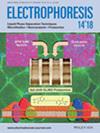封面:利用 MinION 纳米孔测序技术进行现场 STR 分型和人类身份测试的试点验证
IF 3
3区 生物学
Q2 BIOCHEMICAL RESEARCH METHODS
引用次数: 0
摘要
DOI:10.1002/elps.202300234封面图片显示纳米孔测序平台可用于现场个体识别。通过科学合理的设计,将纳米孔 MinION MK1B 设备和其他辅助设备集成到一个便携式检测箱中,有利于在事故现场进行个体识别。可以乐观地预测,生物信息学工作流程和纳米孔测序技术的进一步改进将有助于提高牛津纳米孔技术公司(ONT)设备在事故现场进行实时个体识别的可行性。本文章由计算机程序翻译,如有差异,请以英文原文为准。

Front Cover: Pilot validation of on-field STR typing and human identity testing by MinION nanopore sequencing
DOI: 10.1002/elps.202300234
The cover picture shows nanopore sequencing platforms can be used to identify individuals in the field. Through scientific and reasonable design, a Nanopore MinION MK1B device and other auxiliary devices are integrated into a portable detection box conducive to individual identification at the accident site. It could be optimistically predicted that further improvements in bioinformatics workflows and nanopore sequencing technology will help enhance the feasibility of Oxford Nanopore Technologies (ONT) equipment for real-time individual identification at accident sites.
求助全文
通过发布文献求助,成功后即可免费获取论文全文。
去求助
来源期刊

ELECTROPHORESIS
生物-分析化学
CiteScore
6.30
自引率
13.80%
发文量
244
审稿时长
1.9 months
期刊介绍:
ELECTROPHORESIS is an international journal that publishes original manuscripts on all aspects of electrophoresis, and liquid phase separations (e.g., HPLC, micro- and nano-LC, UHPLC, micro- and nano-fluidics, liquid-phase micro-extractions, etc.).
Topics include new or improved analytical and preparative methods, sample preparation, development of theory, and innovative applications of electrophoretic and liquid phase separations methods in the study of nucleic acids, proteins, carbohydrates natural products, pharmaceuticals, food analysis, environmental species and other compounds of importance to the life sciences.
Papers in the areas of microfluidics and proteomics, which are not limited to electrophoresis-based methods, will also be accepted for publication. Contributions focused on hyphenated and omics techniques are also of interest. Proteomics is within the scope, if related to its fundamentals and new technical approaches. Proteomics applications are only considered in particular cases.
Papers describing the application of standard electrophoretic methods will not be considered.
Papers on nanoanalysis intended for publication in ELECTROPHORESIS should focus on one or more of the following topics:
• Nanoscale electrokinetics and phenomena related to electric double layer and/or confinement in nano-sized geometry
• Single cell and subcellular analysis
• Nanosensors and ultrasensitive detection aspects (e.g., involving quantum dots, "nanoelectrodes" or nanospray MS)
• Nanoscale/nanopore DNA sequencing (next generation sequencing)
• Micro- and nanoscale sample preparation
• Nanoparticles and cells analyses by dielectrophoresis
• Separation-based analysis using nanoparticles, nanotubes and nanowires.
 求助内容:
求助内容: 应助结果提醒方式:
应助结果提醒方式:


